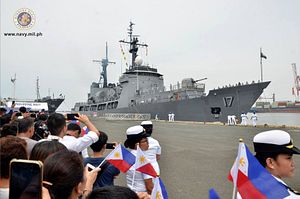On February 3, the Philippines appointed a new navy chief. While this was an expected development, it nonetheless highlighted the issue of what this could mean for the country’s security in general and the development of its naval capabilities more specifically.
As I have noted before in these pages, over the past few years, the Philippines has continued its quest to develop and modernize its military capabilities, with Manila still significantly lagging some of its neighbors in this realm. That effort has continued on under President Rodrigo Duterte, with a mix of continuities as well as changes.
On Monday, the Philippine Navy (PN) was in the spotlight again with the appointment of a new service chief. Giovanni Carlo J. Bacordo was confirmed as the head of the navy, replacing outgoing chief Robert Empedrad, who had reached the mandatory retirement age of 56. Empedrad had held the post since December 2017. Bacordo, a member of the Philippine Military Academy class of 1987, previously served in various positions including head of the Naval Sea Systems Command and Naval Forces Southern Luzon.
Bacordo’s appointment was officially finalized during a change of command ceremony at the PN headquarters in Manila on February 3. During that ceremony, presided over by Duterte, the president expressed his confidence that the navy would “continue to achieve more milestones” under Bacordo’s watch.
While his appointment has only just been finalized, Bacordo has been signaling some of his areas of focus. For instance, in an interview with the Philippine News Agency (PNA), he mentioned the importance of adequate materiel and facilities, including skills, equipment, and supporting infrastructure, to maintain the PN’s vessels and platforms, which has been a key challenge for the military. Bacordo cast this as being an important part of transforming the PN from a “legacy navy” to a “modern navy.
Apart from this, Bacordo also addressed the issue of the naval capabilities of the Philippines more generally, following concerns raised by the decommissioning of more than 20 aging vessels set to occur between this year and the second quarter of 2021. Bacordo emphasized that the focus ought to be not just on the number of vessels, but their capabilities.
To be sure, these priorities are only a slice of what Bacordo will have to contend with in his new post, which includes the same wide range of internal and external maritime challenges that his predecessor had to contend with. And the true test will be the extent to which Bacordo will be able to make inroads in these areas during his tenure as the PN chief. As he does so, it will be interesting to assess how some of his stated and unstated priorities may be translated into reality.

































